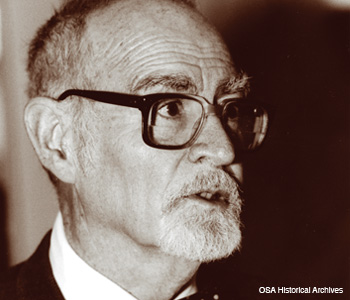 The author, John Howard, served as the founding editor of Applied Optics.
The author, John Howard, served as the founding editor of Applied Optics.
As many OSA members already know, the Optical Society of America was founded in 1916, chiefly by those working in optics at the Eastman Kodak Company and Bausch and Lomb—with a sprinkling of others from the National Bureau of Standards and two or three universities. The earliest papers in OSA's first journal—the Journal of the Optical Society of America (JOSA)—related to lens and camera design, plus vision, optometry and a little spectroscopy.
With the advent of World War I came an increase in articles about range finders, gunsights, spectroscopy and the optical design of cameras for aerial photography. In 1929, the University of Rochester founded its Institute of Optics to improve the teaching of optics, and many of its researchers submitted to JOSA. The outbreak of World War II inspired further coverage of optics for night vision, as well as optical and infrared probing.
After World War II, optics—like other industries—experienced a slowdown. But the field gradually recovered in Europe, chiefly at the Institut d'Optique in Paris. Scientists took a renewed interest in the optical theory of image formation and reconstruction. Then, the advent of the Cold War and the launch of the Soviet satellite Sputnik in 1957 gave optical research yet another boost in the fields of optical detection and probing, particularly in the infrared.
Through all of these changes, the Optical Society survived and slowly grew. Still, in the 1950s—many researchers, and particularly the younger crowd, felt that OSA and its journal, JOSA, were perhaps too slow and staid. Those in OSA who worked mostly in spectroscopy were also eager to form their own society with its own journal. At the same time, some in OSA's leadership also feared that perhaps the infrared community would want to do the same.
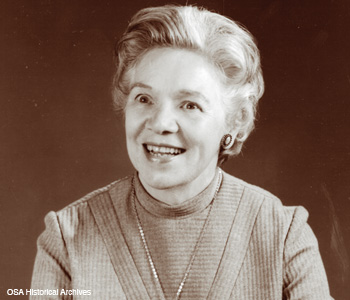 Mary Warga, OSA's first executive secretary.
Mary Warga, OSA's first executive secretary.
The departure of the spectroscopists
Mary Warga, a professor at the University of Pittsburgh (and a spectroscopist), organized an annual March meeting in spectroscopy, which quickly became the major annual gathering of spectroscopists. About the same time, ad hoc groups in several regions organized local spectroscopy societies. In the late 1950s, these groups merged into a new Society of Applied Spectroscopy (SAS). At the Massachusetts Institute of Technology, George Harrison (also a spectroscopist) conducted a popular annual summer course in spectroscopy, and he encouraged the attendees to stay in OSA and publish their papers in JOSA (of which he was the editor).
However, for many, the lure of a spectroscopy society that was targeted to their interests—and that had its own journal—was just too strong. Perhaps half of the OSA members who specialized in spectroscopy gradually drifted away from OSA in favor of SAS. Fortunately for OSA, that shrinkage in membership was largely compensated for by an increase in the number of members who were working in infrared sensing and probing for space and environmental studies.
There was similar discontent among many of the workers in the infrared field. The military was supporting considerable research on the detection of targets (planes, missiles, ships or tanks) by their infrared emission, and NASA had similar interests in space probes. The Office of Naval Research had organized a group called IRIA (infrared information and analysis) to coordinate such sponsored infrared research, and the Office of Naval Research had also organized IRIS (infrared information symposia) meetings for infrared researchers.
By the late 1950s, the annual IRIS meetings were as big as the OSA meetings, and with a large overlap in membership between the two groups. In 1959 and 1960, the two groups even held overlapping meetings at the same location, with IRIS meeting Monday, Tuesday and Wednesday, and OSA meeting Wednesday, Thursday and Friday.
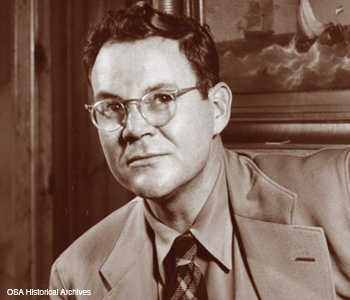 Walter Baird headed the OSA committee that established Applied Optics.
Walter Baird headed the OSA committee that established Applied Optics.
The Subversive Optical Society
In the 1950s and 1960s, the New England local section of OSA was the second largest (after Rochester). During the academic year it met monthly, often to hear a speaker arranged by OSA. The members gathered at a local Boston restaurant for an early supper, after which they listened to the speaker. In the Boston area, there were several "young Turks" who felt that the official OSA spokesperson did not adequately reflect the newest areas of optics—including coherence theory, image formation or the curious interference phenomena reported by Hanbury Brown and Twiss.
These dissident youths showed their defiance of the conventional topics presented at the local section meetings by departing from the assembled group after dinner to hold their own private SOS (Subversive Optical Society) meeting nearby, usually at the Lexington home of Willem Brower of Diffraction Ltd., where they argued and discussed how to use correlation techniques to dig information out of noisy signals or how to understand image formation. (Such topics were also being pursued by the students of Andre Marechal at the Institut d'Optique, or of Abram Van Heel at Delft, or of Toraldo di Francia at Florence.)
Driven by the unhappiness of the SOS members and other activists, OSA's board of directors created a committee to investigate the long-term goals of the Society. (This committee was sometimes called the "Baird Committee" after its chair, Walter Baird.) It was the 1959 report of the Baird Committee that led OSA to establish a central executive office and to start a second journal called Applied Optics (AO), which was intended to capture those papers about modern optics that did not seem to be flowing to JOSA. By the end of 1959, Mary Warga had been appointed as the first executive secretary of OSA's new executive office in Washington D.C.
Another factor that had played into the formation of the Baird committee—and the subsequent establishment of AO—was the 1959 announcement by Pergamon Press that it would launch a new international interdisciplinary journal called Infrared Physics. Would the infraredders desert OSA, as the chemical spectroscopists before them had done? Society activists did not want to chance it, and they prompted OSA to take action.
An OSA executive secretary
Mary Warga was a people person: She enjoyed talking to people, and she was soon making visits to organizations and research laboratories that employed workers in areas involving optics. For example, she visited Bell Laboratories in northern New Jersey and urged those scientists to join the Society and to publish their papers in OSA journals. One early success of her efforts was that Arthur Schawlow immediately joined OSA, and he promised her a paper for the proposed new journal Applied Optics.
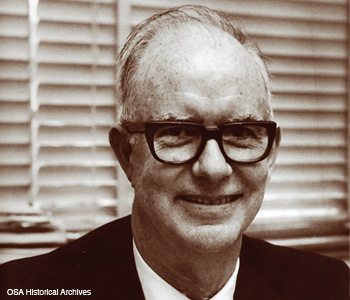 Bruce Billings, the feature editor for the inaugural issue of Applied Optics, lured top talent to submit papers about the search for optical masers.
Bruce Billings, the feature editor for the inaugural issue of Applied Optics, lured top talent to submit papers about the search for optical masers.
Back then, OSA was still a small society, and establishing a central office with a full-time executive secretary put a strain on the Society's resources. But a third recommendation of the Baird Committee was that OSA should undertake to provide a timely English translation of the Soviet journal Optik i Spektroskopie (OiS), and the U.S. National Science Foundation had indicated to OSA that NSF would help fund this translation journal.
With that additional funding, OSA ventured to hire an assistant executive secretary to supervise OiS and to make plans for the proposed new interdisciplinary journal. The Society was most fortunate in being able to recruit Patricia Wakeling for this position. Wakeling had formerly worked for Pergamon Press, and she had considerable experience in launching scientific journals.
In October 1960, the OSA Board approved the concept for Applied Optics, and they appointed me—John N. Howard—as editor. Patricia Wakeling served as the managing editor. The year of 1961 was spent organizing AO. We started by designating feature editors to help stimulate contributed papers, particularly in the exciting areas at the cutting edge of optics research. The launch of Applied Optics was also vigorously publicized to the optics community.
The inaugural issue
Bruce Billings was selected as the feature editor for the January inaugural 1962 issue, with a focus on papers related to the search for optical masers. (Later, he humbly claimed that all he had done was call a few friends and ask them to submit to a new journal.) Billings persuaded Francis Bitter, the head of the MIT National Magnet Lab, to write the lead article, "Magnetic resonance in radiating or absorbing atoms." Billings also convinced Alfred Kastler to submit a paper, "Atomes a l'interieur d'un interferometer Perot-Fabry." Several years later, in 1966, Kastler received a Nobel prize for his work. His paper was an early discussion of a resonant cavity. Billings also received a paper on the hydrogen maser from Norman Ramsay at Harvard, who went on to receive the Nobel in 1989. And, of course, Arthur Schawlow of Bell Labs (another future Nobel laureate, in 1981) made good on his promise to Warga and submitted a paper on composite rod optical masers. So getting started with three papers by such eminent authors added an impressive show of respectability to the new OSA journal! (Even the Nobelist Willis Lamb contributed a book review to the inaugural issue.)
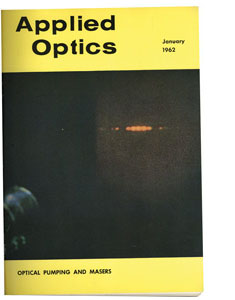 The inaugural issue of Applied Optics, January 1962.
The inaugural issue of Applied Optics, January 1962.
While it's true that most of the papers in the first issue were stimulated by an active feature editor, there were also contributed papers from others who had responded to the ordinary call for papers, including Anthony Siegman, a future president of OSA. Overall, the inaugural issue was a resounding success: It had focused on the hottest current topic—the optical maser (later renamed the laser)—and the papers were high-quality contributions from leading researchers in the field.
Moreover, the managing editor had sent complimentary copies to many libraries, hoping to lure subscriptions. As a result, new contributed papers relating to optical masers began to flow in to this receptive new journal. Around this time, other societies and groups in physics and electrical engineering began to consider starting new journals to serve this rapidly growing area of research. But launching a new journal takes several months of decision-making and preparation. Fortunately, that had all been done already with Applied Optics; it came into existence at just the right time! The IEEE did not begin the Journal of Quantum Electronics, its primary journal in this area, until 1965, by which time AO had already established its piece of the action.
An assertive managing editor
Prior to joining OSA as assistant secretary in 1960, Patricia Wakeling had worked for several years at Pergamon Press, a leading commercial publisher of specialized scientific journals. She was therefore both skilled and experienced in how to successfully launch a journal. She publicized the journal throughout the prospective audience with timely articles from respected leaders in the field, and she sent complimentary copies to potential subscribers. Beyond the lure of high-quality technical content, she had also organized book reviews, meeting reports, columns on optics in industry and in the universities, and even a patents column. Furthermore, she promised timely publication. Thus, it did not take long before there was a steady flow of contributed manuscripts at the cutting edge, and Applied Optics quickly became a leading journal in the new field of quantum optics.
Of course, as the editor of the new journal, I also had responsibilities. It was my job to receive and review the contributed manuscripts, to send them to knowledgeable reviewers for comments on the suitability of each manuscript, to deal with each author, and finally to check that the submitted manuscript had been adequately revised in the light of the comments that the reviewers had made.
Lucky timing
It bears repeating that the primary stimulus for founding Applied Optics had not been the laser. In fact, at the time when the Baird Committee was considering the future goals of the Optical Society, the laser had not yet arrived on the scene. In 1954, Charles Townes at Columbia University had discovered that the ammonia molecule could be stimulated to emit radiation in the microwave region of the spectrum (the first maser), and many bright theoreticians were trying to develop similar stimulated radiation at optical frequencies.
In 1958, Townes and Schawlow had published a paper in Physical Review describing how an "optical maser" should work; and the hunt was on for some experimental verification of this effect. In early 1960, Theodore Maiman at the Hughes Research Laboratory was the first to actually observe laser action.
Meanwhile, Applied Optics had also been approved in 1960, to commence publication in 1962—and it had been approved to serve modern optics, which included but was in no way limited to the laser. (It also covered coherence effects, for example, and Fourier transformed optics.) So it was very lucky indeed for OSA that AO had appeared at just the right time to offer a publication outlet for the laser community. The theory of laser action was still predominantly a matter for papers in Physical Review, but AO was hungry to cover any applications that might arise. The earliest of these turned out to be laser scanners and holography. Most of the other proposed applications (in military devices, say, or in medicine) were still only daydreams and speculations—and for awhile the laser largely remained a "solution in search of a problem."
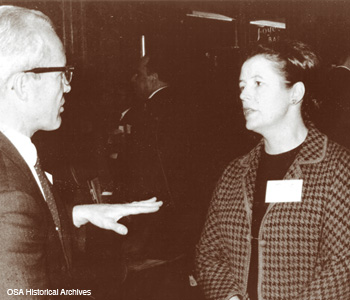 Patricia Wakeling, the highly skilled first managing editor of Applied Optics, talks with Frank Harris, who for many years compiled all of AO's subject indexes.
Patricia Wakeling, the highly skilled first managing editor of Applied Optics, talks with Frank Harris, who for many years compiled all of AO's subject indexes.
Too much of a good thing
There was one shortcoming to having many enthusiastic features editors. Patricia had organized issues around popular topics for each of the other five issues of the first year: space optics, international optics, spectroscopy, infrared and astronomical optics. Each of these topics had an active feature editor who had written or invited an authoritative review paper and also stimulated the audience to contribute more papers.
As a result, I was inundated by papers on all of these topics. For the features on spectroscopy and astronomical optics, we had to schedule second issues (in 1963) to accommodate the surge of contributed papers. I soon had to gently caution the feature editors to be slightly less vigorous in shaking the tree for papers. Then we then tried holding the papers on each featured topic to occupy no more than half of each issue, so that we would have more room for papers on other topics.
We had originally planned that individual issues of AO would only be about the same size as JOSA (that is, about 100 pages per issue), and the journal was launched with a bimonthly publication frequency. However we soon realized that—in order to keep up with the submissions—we would need to make AO a monthly journal in 1963. We requested, and received, approval from the OSA board to make this happen. Even with those additional issues, we soon built up a backlog. Printing and mailing a journal costs money, and the OSA treasurer was reluctant to see AO's costs rise faster than subscription income.
Was AO growing too fast?
Soon the board was faced with the consequences of AO's rapid ascent: The journal was growing—in pages printed and manuscripts received—much faster than JOSA, the Society's premier journal. In 1964, I had to ask the board to approve a larger page budget for AO in order to keep up with the flow of papers. If there is a backlog of manuscripts waiting to appear, it is more difficult to promise authors that their submitted manuscripts will appear promptly in the next available issue, and the authors of papers describing true scientific breakthroughs might turn away from AO in search of another journal with faster publication.
The board of directors faced another problem as well—a swelling number of new journal-related board members. From OSA's beginning, the editor of JOSA had been made a full voting member of the board. So, when AO was approved as a second journal of the Society, OSA kept with this convention, and I became a full voting member of the board as well.
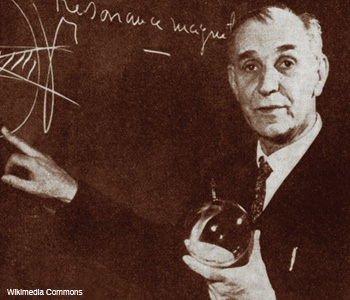 Alfred Kastler is one of the future Nobel prize winners who contributed a paper to the first issue of Applied Optics.
Alfred Kastler is one of the future Nobel prize winners who contributed a paper to the first issue of Applied Optics.
At the same time, the board was also contemplating adding a new letters journal. If the editor of that journal were to also become a full member of the board, the board would be skewed towards journal editors and their problems, and correspondingly less weight would be given to other Society interests, such as meetings, technical groups or education. The board attempted to solve this problem by creating an editorial board comprised of the editors of all of the OSA journals. Only the chair of this board would be a voting member of the board of directors, thereby representing—in a single person—the interests of the entire journals program. Today, this entity is referred to as the board of editors.
So one of the immediate problems that the chair of OSA's new editorial board faced was how to restrain the vigorous growth of AO compared with JOSA. When confronted with a request that the page budget of AO be increased, the chair suggested that perhaps I should drastically tighten my refereeing process. If perhaps half of the arriving contributed manuscripts were turned down, then surely AO would stop growing faster than JOSA.
I was very reluctant to pursue that route, for two important reasons. First, AO already had a rejection rate very similar to that of JOSA. This was partly because both journals were drawing largely from the same pool of referees. AO had already become a journal with a quality level comparable to JOSA. Secondly, papers that are turned down, say by AO, do not disappear; they would probably simply be resubmitted elsewhere to the competing journals published by the Physical Society, IEEE, SPIE or others. Why fatten those journals if authors prefer OSA's publications?
Laser papers in JOSA and AO: The first dozen years
Applied Optics had begun with a bold inaugural issue containing several laser papers, and soon applications of lasers had become a steady topic featured in the journal. JOSA, even though it was the premier journal of the Society, was slower to turn to that topic. It was not until Robert Terhune drastically reorganized JOSA in 1984 into two new journals—JOSA A and JOSA B—that these publications began to contain a respectable number of laser papers. The reason was that each of the new associate editors for JOSA A and JOSA B vigorously pursued papers relating to laser physics.
One way to compare AO and JOSA in the first dozen years after the laser had emerged is to examine the cumulative indexes of the two journals, listing papers up through 1973. For Applied Optics, there are 1,380 entries under "lasers," plus 630 under "holography," 420 under "laser scanners," and about 940 on fiber optics, integrated optics, resonators, modulators and so on, for a total of 3,370 citations.
For JOSA through 1973, there are 770 entries under "lasers," 560 under "holography," and about 60 under "integrated optics," for a total of 1,390 entries. However, with the appearance of JOSA A and JOSA B, the two JOSAs had pulled up even with AO in laser papers by the mid-1980s. Nevertheless, it is fair to conclude that AO published the larger share of papers relating to lasers in those heady early years of laser development: At least within OSA, Applied Optics had won the laser race.
John N. Howard is the founding editor of Applied Optics and retired chief scientist of the Air Force Geophysics Laboratory.
